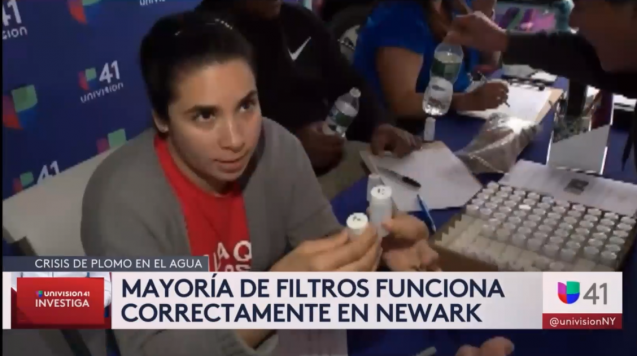Journalists and Geochemists Team Up to Test for Lead in Newark’s Water
With help from local tv station Univision 41, Earth Institute scientists tested how well Newark’s lead filters are working. The results support new findings from city officials.

Officials in Newark, NJ, announced yesterday that water filters distributed by the city have been mostly effective at limiting lead to safe levels in residents’ drinking water.
After decades of struggling with lead in its water, the Newark city government distributed some 38,000 PUR water filters to residents last fall. The city’s new study analyzed 1,700 water samples from 300 households, and found that 97 percent of those filters are working properly, limiting lead in tap water to below 15 parts per billion, the level set by the Environmental Protection Agency.
The announcement comes after scientists at Columbia University’s Lamont-Doherty Earth Observatory and journalists at Univision had decided to run their own tests of how well the water filters were working. In a previous test in August, city officials had tested three of the filters and found that two of them failed.

After a live, televised event in early September, Univision 41 reporter Jose Pagliery got viewers to turn in 76 pairs of water samples. One sample in each pair came straight from the tap, and the other had been run through the government-distributed filter. Lamont geochemist Alexander van Geen and lab manager Tyler Ellis analyzed these samples.
The partnership was mutually beneficial, said van Geen, because the Spanish-language television station recruited more volunteers than the scientists would have been able to enroll by themselves, while the scientists provided quick testing at no cost to the station.
The analysis revealed that 11 of the samples that came straight out of the tap contained lead levels above 15ppb. Of the 11 corresponding samples of filtered water, one exceeded 15ppb — meaning the filter had failed to clean the water to EPA standards.
“There are a few ways to interpret this,” said van Geen. One interpretation is that almost 10 percent (1/11) of the filters weren’t working properly. Another interpretation is that only 1 percent (1/76) of the filters weren’t working properly. (The latter method is how the city decided to announce its results, but it did not provide the lead levels in the water entering the 300 filters.)
Taking into account the limited number of filters tested, the Columbia measurements suggest that between less than 1 and 4 percent of all the filters may have failed — which is consistent with the city’s findings of 3 percent.
Van Geen admits that while the smaller size of the Columbia study limits how far the results can be interpreted, the results could help to lend credibility to the city’s study. After years of neglect, mismanagement, corruption, and lack of transparency, the lead crisis has eroded trust between Newark residents and their government.
The good news is that the Columbia study also found that, on average, the filtered water had 10 times less lead than the unfiltered water. “It’s clear that when they work, the filters are doing a good job,” said van Geen.
However, while the city’s 3 percent failure rate seems low, van Geen cautioned that it could still affect a lot of people. If 3 percent of the 38,000 filters are not properly filtering out lead, some 1000 households could be at risk.
The city of Newark will be continuing to provide free testing and bottled water to residents.
Newark’s water crisis is caused by the corrosion of lead pipes and improper maintenance. Since the city began adding orthophosphate, which forms a protective coating on the insides of pipes to prevent further corrosion, the city reports that lead levels in the water supply are decreasing. The city also expects to spend $75 million replacing lead service lines in the coming years.
“Lead exposure from various sources, including lead paint and leaded gasoline, used to be higher two decades ago,” said van Geen. “Things have improved a lot, but you still want to minimize lead exposure as much as possible. There’s no safe level of lead.”
